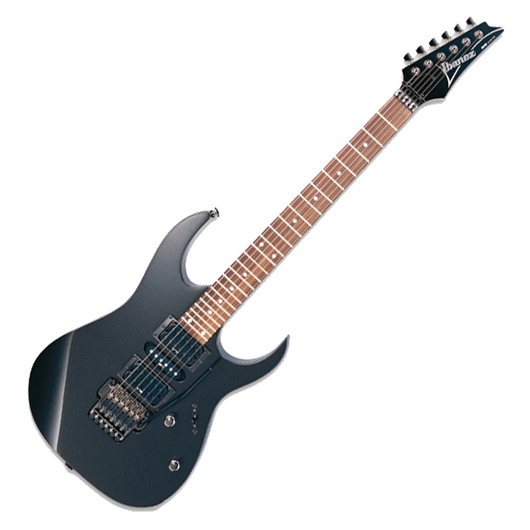History
The Hoshino Gakki company began in 1908 as the musical instrument sales division of the Hoshino Shoten, a bookstore company. The Ibanez brand name dates back to 1929 when Hoshino Gakki began importing Salvador Ibáñez guitars from Spain. When the "Salvador Ibáñez" workshop was destroyed during the Spanish Civil War, the "Ibanez Salvador" guitars were no longer available, so Hoshino Gakki bought the "Ibanez Salvador" brand name rights and started making Spanish acoustic guitars in 1935, at first using the "Ibanez Salvador" brand name, and then later using the "Ibanez" brand name.
The modern era of Ibanez guitars began in 1957 and the late 1950s and 1960s Ibanez catalogues show guitars with some wild looking designs . Japanese guitar makers in the 1960s were mostly copying European guitar designs and some of the late 1960s Ibanez designs were similar to Hagström and EKO guitar designs. Hoshino Gakki used the Teisco and FujiGen Gakki guitar factories to manufacture Ibanez guitars after they stopped manufacturing their own guitars in 1966 and after the Teisco guitar factory closed down in 1969/1970 Hoshino Gakki used the FujiGen Gakki guitar factory to make most Ibanez guitars.
In the 1960s Japanese guitar makers started to mainly copy American guitar designs and Ibanez branded copies of Gibson, Fender and Rickenbacker models started to appear. This resulted in the so called Ibanez lawsuit period. After the lawsuit period Hoshino Gakki introduced Ibanez models that were not copies of the Gibson or Fender designs such as the Iceman and Ibanez Roadstar. The company has produced its own guitar designs ever since. The late 1980s and early 1990s were an important period for the Ibanez brand. Hoshino Gakki's relationship with Frank Zappa's former guitarist Steve Vai resulted in the introduction of the Ibanez JEM and the Ibanez Universe models and after the earlier successes of the Roadstar and Iceman models in the late 1970s/early 1980s, Hoshino Gakki entered the superstrat market with the RG series which were a lower priced version of the Ibanez JEM model.
Hoshino Gakki also had semi acoustic, nylon and steel stringed acoustic guitars manufactured under the Ibanez name. Most Ibanez guitars were made for Hoshino Gakki by the FujiGen guitar factory in Japan up until the mid to late 1980s and from then on Ibanez guitars have also been made in other Asian countries such as Korea, China and Indonesia. During the early 1980s the FujiGen guitar factory also produced most of the Roland guitar synthesizers, including the Stratocaster-style Roland G-505, the twin-humbucker Roland G-202 (endorsed by Eric Clapton, Dean Brown, Jeff Baxter, Yannis Spathas, Steve Howe, Mike Rutherford, Andy Summers and Steve Hackett) and the Ibanez X-ING IMG-2010.
Cimar and Starfield were guitar brands owned by Hoshino Gakki. In the 1970s, Hoshino Gakki and Kanda Shokai shared some guitar designs and so some Ibanez and Greco guitars have the same features. The Kanda Shokai Greco guitars were sold in Japan and the Hoshino Gakki Ibanez guitars were sold outside of Japan. From 1982, Ibanez guitars have also been sold in Japan as well as being sold outside of Japan .
Guitar brands such as Antoria shared some Ibanez guitar designs. The Antoria guitar brand was managed by JT Coppock Leeds Ltd England. CSL was a brand name managed by Charles Summerfield Ltd England. Maurice Summerfield of the Charles Summerfield Ltd company contributed some design ideas to Hoshino Gakki and also imported Ibanez and CSL guitars into the UK with Hoshino Gakki cooperation from 1964-1987 The Maxxas brand name came about because Hoshino Gakki thought that the guitar did not fit in with the Ibanez model range and was therefore named Maxxas by Rich Lasner from Hoshino USA.
Lawsuit
.
Harry Rosenbloom, founder of the (now-bankrupt) Medley Music of Bryn Mawr, Pennsylvania, was manufacturing handmade guitars under the name "Elger." By 1965 Rosenbloom had decided to stop manufacturing guitars and chose to become the exclusive North American distributor for Ibanez guitars. In September 1972 Hoshino began a partnership with Elger Guitars to import guitars from Japan. In September 1981, Elger was renamed "Hoshino U.S.A.", retaining the company headquarters in Bensalem, Pennsylvania as a distribution and quality-control center.
The lawsuit was brought by the Norlin Corporation, the parent company of Gibson guitars against Elger/Hoshino U.S.A. on June 28, 1977 in the Philadelphia Federal District Court, and was based on the Gibson headstock design. Hoshino settled out of court in early 1978 and the case was officially closed on February 2, 1978.
After the lawsuit Hoshino Gakki abandoned the strategy of copying "classic" USA electric guitar designs and moved to the popular superstrat era in the mid-1980s. The newer Ibanez models began incorporating more modern elements into their design such as radical body shapes, slimmer necks, 2-octave fingerboards, slim pointed headstocks, higher-output electronics, humbucker/single-coil/humbucker (H/S/H) pickup configurations, locking tremolo bridges and different finishes.

























No comments:
Post a Comment